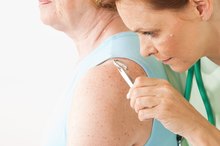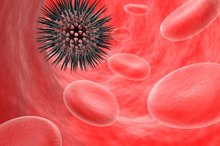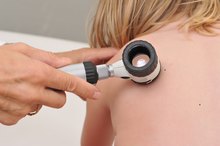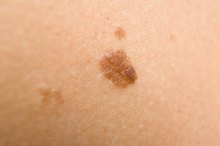What does fact checked mean?
At Healthfully, we strive to deliver objective content that is accurate and up-to-date. Our team periodically reviews articles in order to ensure content quality. The sources cited below consist of evidence from peer-reviewed journals, prominent medical organizations, academic associations, and government data.
The information contained on this site is for informational purposes only, and should not be used as a substitute for the advice of a professional health care provider. Please check with the appropriate physician regarding health questions and concerns. Although we strive to deliver accurate and up-to-date information, no guarantee to that effect is made.
Age Spots and Moles
Age spots and moles are two distinct irregularities that can appear on the surface of your skin. Age spots typically appear as a result of sun exposure and advancing age. Moles may be present at birth or appear later in your life. Although both types of irregularity typically pose no health risks, certain types of moles may present an increased risk for the development of skin cancer.
Age Spots
They typically appear as painless, flat patches of skin that vary in color from light brown to black. Age spots commonly occur in people older than 40. In some cases, you may develop age spots for unknown causes not related to age or sun exposure.
Moles
Differences between Malignant Melanoma and a Normal Mole
Learn More
Moles commonly occur throughout the population, according to the Merck Manuals Online Medical Library 2. They can range in size from tiny dots to areas in excess of an inch in diameter. Depending on individual circumstances, you may have moles that are raised or flat, hairy or hairless and rough or smooth. Typical colors for moles include brown or dark brown, but you may also have moles that range from light yellow to flesh-colored. In most cases, moles appear on your skin during childhood or adolescence, but they may also appear at birth or later in life.
- Moles commonly occur throughout the population, according to the Merck Manuals Online Medical Library 2.
- Typical colors for moles include brown or dark brown, but you may also have moles that range from light yellow to flesh-colored.
Age Spot Effects
Despite their common nickname, age spots don’t have any link to the status of your liver function, Medline Plus says. Although they cause permanent changes in the appearance of your skin, they don't typically indicate the presence of any health problems. In some cases, an age spot may develop irregular borders similar to those found in skin cancer. If you have a spot of this type, your doctor can test it to determine its true composition. The presence of normal age spots may also sometimes obscure the presence of skin cancer cells, Medline Plus says.
- Despite their common nickname, age spots don’t have any link to the status of your liver function, Medline Plus says.
- The presence of normal age spots may also sometimes obscure the presence of skin cancer cells, Medline Plus says.
Mole Effects
Cherry Angioma & Skin Cancer
Learn More
Moles are not cancerous and they typically don't hurt or itch, the Merck Manuals says 2. However, cancerous changes can occur within mole tissue. Potential signs of these changes include:
- itching
- inflammation
- darkening or other color changes
- pain
- bleeding
- mole enlargement with or without the development of irregular borders
As a rule, you should monitor your moles and report suspicious changes to your doctor. Moles that are present from birth have a greater chance of developing cancerous changes, according to the American Academy of Dermatology. You also have an increased skin cancer risk if you have more than 50 to 100 moles that appear at any point after birth.
- Moles are not cancerous and they typically don't hurt or itch, the Merck Manuals says 2.
- Moles that are present from birth have a greater chance of developing cancerous changes, according to the American Academy of Dermatology.
Skin Protection
You can decrease your risks for developing age spots or cancerous moles by protecting your skin from sun exposure, Medline Plus and the Merck Manuals say 2. Options for protection include using high-SPF sunscreen, avoidance of midday sunlight and wearing clothing that reduces sun exposure.
Related Articles
References
- Medline Plus - U.S. National Library of Medicine - National Institutes of Health: Liver Spots
- The Merck Manuals Online Medical Library: Moles
- American Cancer Society. Key statistics for melanoma skin cancer. Updated August 14, 2019.
- Children's Hospital of Philadelphia. Congenital nevus (mole).
- U.S. National Library of Medicine Genetics Home Reference. Are moles determined by genetics? Updated December 2017.
- National Cancer Institute. Genetics of skin cancer (PDQ) - health professional version. Updated January 3, 2020.
- American Society of Clinical Oncology. Melanoma: symptoms and signs. Updated January 2019.
- Skin Cancer Foundation. Melanoma warning signs. Updated April 2019.
- National Cancer Institute. Melanoma risk assessment tool.
- American Cancer Society. How to Spot Skin Cancer. Updated 07/06/17. https://www.cancer.org/latest-news/how-to-spot-skin-cancer.html
- Canadian Cancer Society. Signs and Symptoms of melanoma skin cancer. http://www.cancer.ca/en/cancer-information/cancer-type/skin-melanoma/signs-and-symptoms/?region=on
Resources
Writer Bio
M. Gideon Hoyle is a writer living outside of Houston. Previously, he produced brochures and a wide variety of other materials for a nonprofit educational foundation. He now specializes in topics related to health, exercise and nutrition, publishing for various websites.









